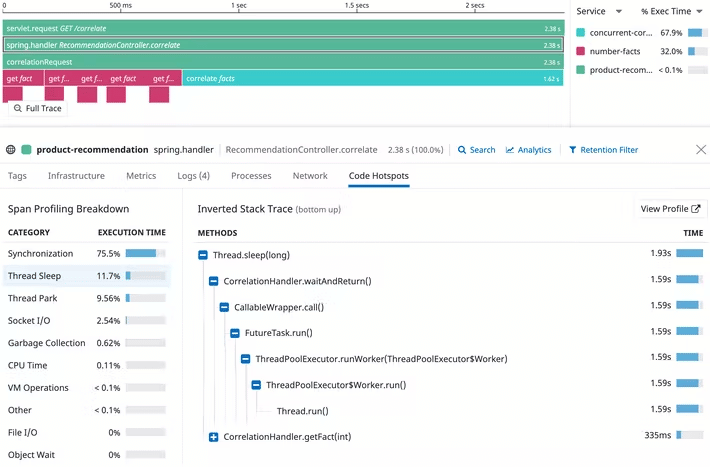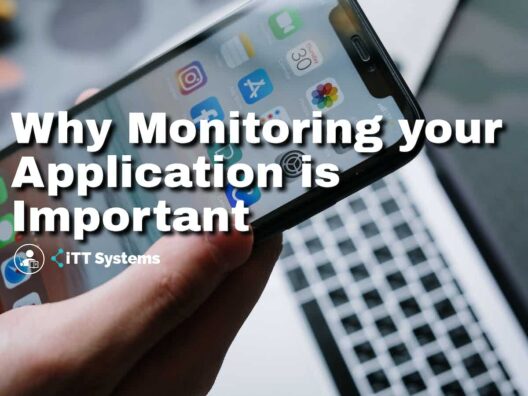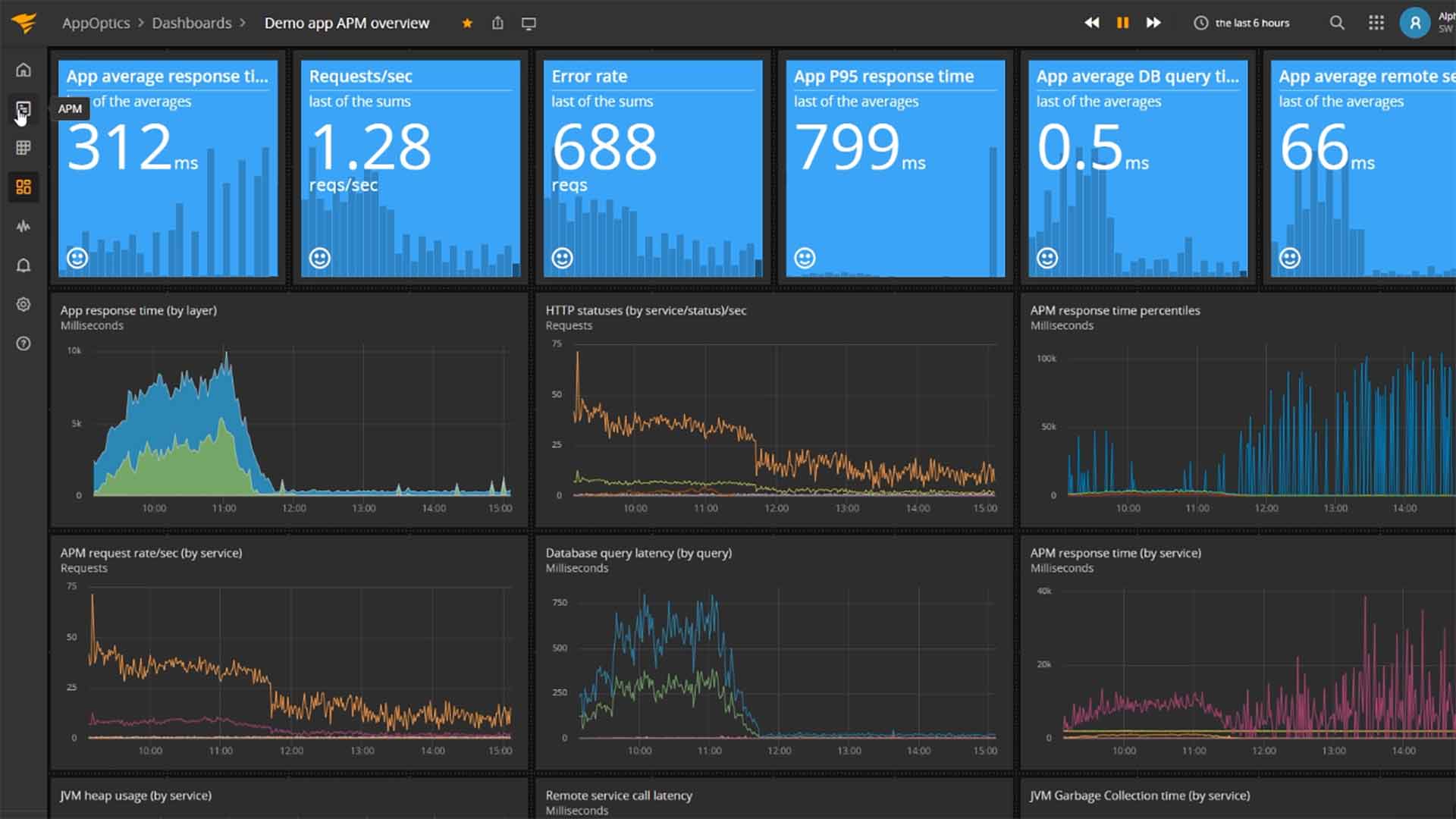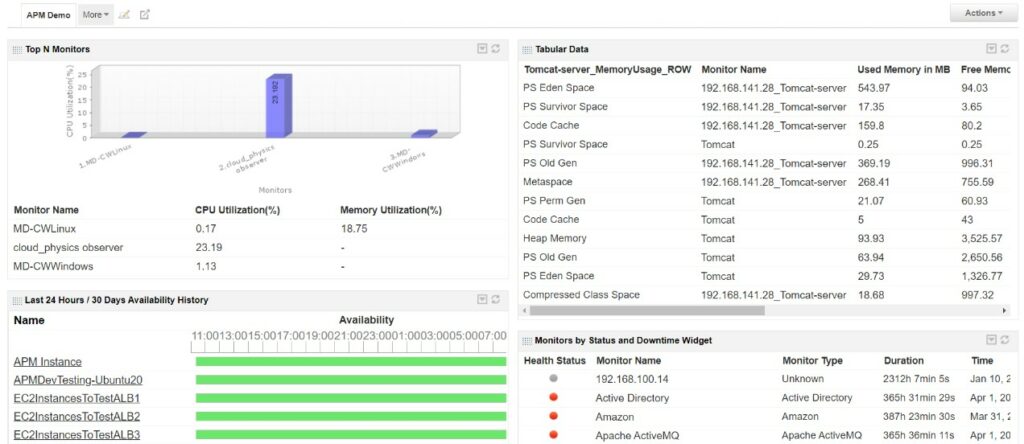Applications are the driving engines of any organization and almost every organization, regardless of its size, uses them for a wide range of activities from marketing to improving employee productivity and everything in between. Since these applications are such a critical part of your organization, it's important to ensure they always work optimally. This is where application monitoring comes into play.
Application monitoring is the process by which you stay on top of the health and performance of applications within your organization. Often, organizations have hundreds of custom and third-party apps within the organization, and this makes it impossible for any individual or team to monitor these apps round-the-clock. Thankfully, there are application monitoring apps that continuously look into the performance of applications and send notifications in case of issues.
Here is our list of the best application monitoring platforms:
- SolarWinds AppOptics – EDITOR'S CHOICE – FREE TRIAL: SolarWinds AppOptics APM stands out for its scalability and continuous visibility, making it ideal for monitoring diverse applications across any infrastructure. Its intuitive dashboards and advanced alerting options significantly reduce MTTR, enhancing operational efficiency.
- SolarWinds Server & Application Monitor – FREE TRIAL: SolarWinds SAM excels with its interactive visual mapping and full-stack observability, streamlining application and server monitoring across various environments.
- ManageEngine Applications Manager – FREE TRIAL: ManageEngine Applications Manager shines in monitoring applications across development stages and cloud environments, ensuring enhanced performance and reduced downtimes.
- Datadog APM: Datadog APM is notable for end-to-end tracing and real-time insights, optimizing code performance and providing comprehensive application monitoring.
In this article, we will discuss four of the best application monitoring tools available today, so you can make an informed decision as to which is a good fit for your organization. But before that, let's talk about the importance of monitoring and why you need an application monitoring tool in the first place.
Why Should You Monitor Your Application?
Applications are built to be stable and reliable, so why should you bother monitoring their performance and health? And why do you need application monitoring tools and platforms to handle this monitoring for you? Here are some reasons.
Manages Increased Complexity
When you build an application, you would have certain targets in mind. However, when your business grows and expands over time, these targets may seem modest. For example, you could build a website that can handle about one million footfalls a day. Let's say your business grows by an average of 20% every year, which means, your footfalls would double in five years.
The underlying infrastructure and technology may not be ready to handle this additional load, and it could cause issues like downtimes and breakdowns. In turn, this can impact your end users and through it, your organization's reputation. To avoid these repercussions, an application monitoring tool can proactively inform you about an impending breakdown, so you can take corrective action right away.
Handles Interdependencies
Like growing complexity and workload, interdependencies among applications can increase too. Say, for example, you had ten apps when you started, and soon you added more apps to meet the different needs of your organization. Before you know it, the number of apps and their interdependencies can get out of control. In such cases, application monitoring tools monitor specific metrics and inform you when there are performance drops.
Eases Troubleshooting
Most application monitoring platforms today come with Artificial Intelligence (AI) and Machine Learning (ML) capabilities to not just monitor specific metrics, but also point you to the underlying cause of the issue. Many times, you get the necessary contextual information to quickly fix the problem. Needless to say, this can reduce the Mean Time To Resolution (MTTR) and you can address issues before they impact the wider organization.
Reduces Maintenance Costs and Effort
Application monitoring tools continuously look into the performance of applications and send notifications in case of major deviations from the established metrics. These notifications enable you to fix problems before they occur, thereby reducing repair costs. They can even reduce your operational costs and effort in the long run.
Enhances User Experience
As mentioned earlier, regular monitoring of different metrics identifies issues before they create a wider impact. In particular, it reduces the chances of frequent downtimes that can impact end users' accessibility and experience. Such uptimes and the ability of end users to easily navigate to different aspects of your application can even boost their overall experience.
Provides Analytics
In today's world, analytics plays a key role as it helps you to correlate and make sense of different events that happen within your organization. Application monitoring tools greatly help with analytics as they tend to have detailed logging mechanisms that capture every aspect of an application's work. When you combine these analytics collected across applications, you can better understand the state of your infrastructure and the breakup of your maintenance costs.
In turn, such detailed analytics can help with capacity planning and budgeting. It can also help you to better understand the dynamics of your industry and how your organization fares amongst competitors. Besides, you can get a realistic picture of how your applications perform and what you can do to gain a competitive advantage through them.
Meets Compliance
Many laws and regulations have strict compliance provisions, and failure to meet these provisions can attract hefty fines. Application monitoring platforms help you to meet these compliance targets comfortably.
Integrates with Other Tools
Most application monitoring tools available today integrate with existing third-party and custom tools within your organization to create a seamless flow of data across them. Such easy integrations save a lot of time and effort in managing and maintaining applications. More importantly, these tools can give a holistic view of how your applications perform currently and the improvements needed to improve their efficiency.
Provides Control and Visibility
As an organization grows, it becomes increasingly hard to stay on top of every aspect of operations and the applications that drive them. This is where application monitoring tools come in handy as they collate information and present them in the form of dashboards and reports. As a result, a mere glance at these dashboards and reports is enough to understand what's going on within the organization. Furthermore, it enables IT admins to have the control and visibility needed across organizational activities.
Enables Optimum Resource Usage
Application monitoring tools continuously assess the performance of applications and the resources they consume within the organization. Depending on your goals, you can set up metrics such as bandwidth usage, CPU utilization, etc, and these metrics help you to better understand the organizational resources consumed by individual applications.
Based on this information, you can streamline resource usage to ensure that your most critical applications always have priority when it comes to the usage of network resources. It can even help you to implement strategies such as throttling to limit the consumption of resources by the least important applications.
Furthermore, you can also schedule and plan operations better. For example, you can batch together resource-intensive tasks and run them during the off-hours to ensure better usage of resources.
Implements Security
Security is another essential part of any organization's operations, and the metrics gathered by these application monitoring tools can help you to identify security gaps and vulnerabilities. According to the information gathered and the seriousness of the identified vulnerability, you can plan to fix them right away.
The other advantage of application monitoring tools is that they ease the process of implementing security controls and policies across the organization. By gathering the performance metrics, these tools help you to better evaluate the impact of your policies on the performance of applications. Based on these metrics, you can make informed decisions about changing/maintaining the existing policies.
Overall, application monitoring tools provide a ton of benefits for an organization. They go over and beyond just monitoring applications, as you can use the metrics collected for a wide range of decisions and their respective implementations.
That said, not all application monitoring tools are built the same, so you have to choose a tool that best fits your organization. Some tools like the ones we have described below are comprehensive and can help your organization greatly leverage the benefits of these tools.
Methodology for Selecting an Application Monitoring Platform:
- Focus on scalability to ensure the tool can grow with the organization.
- Prioritize platforms offering continuous and comprehensive visibility across all applications.
- Look for tools that reduce Mean Time To Resolution (MTTR) and enhance operational efficiency.
- Consider platforms with a high number of integrations for extensive compatibility.
- Emphasize on tools providing detailed contextual information for errors and intuitive dashboards for ease of use.
- Seek out platforms with advanced alerting options for proactive monitoring.
1. SolarWinds AppOptics – FREE TRIAL
AppOptics is a popular application monitoring platform that can continuously monitor your applications to reduce downtimes and optimize resource usage. It supports applications hosted on servers, containers, on-prem infrastructure, cloud, and just about anywhere else. The highlight of this tool is that it simplifies the process of monitoring all kinds of applications, including legacy and custom-built ones, and through it, provides the insights and business analytics needed to enhance your operational efficiency.
Key Features:
- Highly scalable and grows with your organization.
- Provides continuous visibility into all the applications in your entire infrastructure.
- Enables you to drill down to the specific metrics of an application with just a few clicks.
- Reduces the Mean Time To Resolution (MTTR).
- Comes with 150+ turn-key integrations.
- Provides contextual information for errors using strategies such as distributed tracing, live code profiling, and exception tracking.
- Offers intuitive dashboards for easy understanding and complete visibility of applications' performance.
- Provides proactive and advanced alerting options to stay on top of key metrics.
- Monitors both client-side and server-side applications.
Why do we recommend it?
SolarWinds AppOptics is highly recommended for its robust scalability and comprehensive visibility into application performance. It excels in reducing downtime and optimizing resource usage across diverse infrastructures, making it a reliable choice for continuous application monitoring.
Who is it recommended for?
This tool is ideal for organizations looking to monitor a wide range of applications, from legacy to custom-built, across various environments. It's especially suited for businesses seeking a scalable solution that offers detailed insights and analytics to enhance operational efficiency.
In all, AppOptics is a cost-effective and efficient tool for monitoring all applications across your infrastructure.
Pros:
- Highly scalable, adapting to organizational growth.
- Provides continuous and detailed visibility across all applications.
- Allows quick access to specific application metrics.
- Effectively reduces Mean Time To Resolution (MTTR).
- Features over 150 turn-key integrations for versatility.
- Advanced alerting options for proactive monitoring.
Cons:
- Might be complex for beginners to navigate initially.
EDITOR'S CHOICE
SolarWinds AppOptics is our top choice for an application monitoring platform due to its exceptional scalability and ability to provide continuous, in-depth visibility into a wide range of applications. Its user-friendly interface, coupled with advanced features like distributed tracing and live code profiling, make it an invaluable tool for enhancing operational efficiency and optimizing resource usage. The platform’s ability to handle both legacy and custom-built applications with ease further solidifies its position as a leader in this space.
Download: https://www.solarwinds.com/appoptics/use-cases/application-performance-monitoring
Official Site: https://www.solarwinds.com/appoptics/use-cases/application-performance-monitoring
OS: Cloud-Based
2. SolarWinds Server & Application Monitor – FREE TRIAL
Server & Application Monitor (SAM) is a suite of tools to monitor applications and servers across your infrastructure. You can track the progress of each server/application through a web console that can be accessed from anywhere. A highlight of this tool is that it comes with hundreds of templates that you can use to monitor more than 200 types of applications across private, public, and hybrid environments.
Key Features:
- Offers an interactive visual mapping tool to understand the context of issues and performance lags.
- Its intuitive dashboard makes it easy to correlate real-time and historical data to gain in-depth perspectives.
- Allows you to keep track of all applications' performance and health, regardless of where they are hosted/deployed.
- Collects data using the API Poller and analyzes them for in-depth insights.
- Detects dependencies for better planning.
- Sends customizable alerts and their underlying context.
- Provides full-stack observability for more efficient troubleshooting.
- Eliminates tool sprawl and brings down maintenance costs.
- Helps with budgeting and capacity planning.
Why do we recommend it?
SolarWinds Server & Application Monitor is recommended for its exceptional ability to offer comprehensive monitoring of applications and servers. Its use of interactive visual mapping and an intuitive dashboard makes it easy to track and analyze performance across diverse environments.
Overall, SolarWinds SAM is a comprehensive tool that takes your application and server monitoring to new heights. Its in-depth insights and contextual information add a ton of value to your organization. Above everything, it's simple to use and scales well with your growth.
Who is it recommended for?
This tool is particularly suitable for IT professionals and organizations that need to monitor a wide range of applications and server health, especially those operating in hybrid or multi-cloud environments.
Pros:
- Interactive visual mapping aids in understanding performance issues.
- Intuitive dashboard for correlating real-time and historical data.
- Monitors applications' health and performance comprehensively.
- API Poller for insightful data analysis.
Cons:
- Pricing might be a barrier for small businesses or startups.
The pricing starts at $1,663.
Website Link: https://www.solarwinds.com/server-application-monitor
Download: Click here for a fully functional 30-day free trial
3. ManageEngine Applications Manager – FREE TRIAL
ManageEngine Applications Manager simplifies the complex monitoring process and at the same time, provides the insights you need for planning and optimizing the performance of different applications within your infrastructure. In particular, it provides deep visibility into your critical applications and infrastructure components to resolve any performance or latency issues before it impacts your end customers.
This platform combines many individual components such as application performance monitoring, synthetic transaction monitoring, and real user monitoring to deliver superior business outcomes for any organization. It even automates IT and DevOps processes to streamline the development and deployment of applications.
Key Features:
- Monitors applications in dev, QA, and staging environments.
- Supports the monitoring of applications built on a wide range of platforms such as Ruby, Java, .NET, and more.
- Tests the performance of critical user paths to improve the overall end-user experience.
- Checks for application performance from real browsers and environments.
- Generates insights based on geographies, devices, user sessions, networks, response times, and more.
- Monitors workloads and evaluates the performance of applications across any cloud environment.
- Enables you to plan effectively to prevent downtimes due to resource shortages.
- Provides agentless monitoring of different databases.
- Auto discovers applications and maps their dependency in real-time.
Why do we recommend it?
ManageEngine Applications Manager is recommended for its holistic approach to application monitoring, combining various monitoring components to deliver superior outcomes. Its focus on optimizing performance and preemptive issue resolution makes it a valuable tool for any organization.
Overall, ManageEngine Application Manager optimizes applications and their resource usage, so your maintenance costs and downtime chances reduce greatly. Furthermore, it enhances your processes' efficiency and enables you to respond to incidents faster.
Who is it recommended for?
This tool is ideal for businesses seeking deep visibility into critical applications and infrastructure components, especially those in diverse environments including cloud, on-premises, and hybrid setups.
Pros:
- Monitors applications across different development stages and environments.
- Supports a wide range of application platforms for versatile monitoring.
- Improves user experience by testing critical user paths.
Cons:
- Might require a learning curve to fully utilize its advanced features.
Get started with a 30-day free trial.
4. Datadog APM

Datadog APM is a modern platform that's well-suited for monitoring different types of applications across your entire infrastructure. This tool offers end-to-end tracing of all your applications and even individual lines of code to provide a comprehensive view of your applications' performance at any time. Furthermore, Datadog APM correlates the frontend and backend data to monitor the dependencies that exist between applications. By combining information from these different sources, you can reduce downtime and latency, improve performance, and bring down maintenance costs.
Its real-time insights provide complete visibility into the state of your operations, so you can take the necessary action to meet your organization's goals. These insights also help with faster troubleshooting and proactive alerting.
Key Features:
- Enables you to monitor KPIs using custom tags.
- Helps to optimize your code, so your applications can perform better.
- Monitors different services and endpoints within your application to identify any bottlenecks in performance.
- Creates visual dependency maps with its Service Map feature.
- Comes with out-of-the-box dashboards for easy visibility and control.
- Integrates well with hundreds of third-party applications.
- Leverages OpenTelemetry and OpenStandards to manage applications.
- Reliable, flexible, and highly scalable.
- Retains only the most relevant information by using tag-based retention filters.
Why do we recommend it?
Datadog APM is highly recommended for its end-to-end application tracing and comprehensive monitoring capabilities. It excels in correlating frontend and backend data, which is crucial for understanding application dependencies and improving overall performance.
In all, Datadog APM is an advanced application monitoring platform that can quickly identify performance issues and provide the context for the same to ease troubleshooting. Its many features such as distributed tracing and live code analysis help to finetune applications and improve their performance. Datadog helps with reporting, auditing, and compliance as well.
Who is it recommended for?
This platform is particularly suited for organizations requiring detailed performance analysis across their entire infrastructure, from individual lines of code to complete application health.
Pros:
- Custom tags for monitoring KPIs enhance performance optimization.
- Identifies bottlenecks in services and endpoints effectively.
- Service Map feature creates visual dependency maps.
Cons:
- The comprehensive features might be overwhelming for smaller teams or less complex environments.
Click here to start a free trial.
Summary
To conclude, continuous monitoring of your applications is essential for not just the improved performance of your applications but also to ensure optimal resource utilization, reduced downtime, easy troubleshooting, and improved security. That said, it's not easy to manually monitor applications' performance and this is where automated application monitoring tools become critical.
However, choosing the appropriate application monitoring platform is not easy, and this is why we described the best choices available today. We hope they help you to decide the best fit for your organization's application monitoring requirements.







